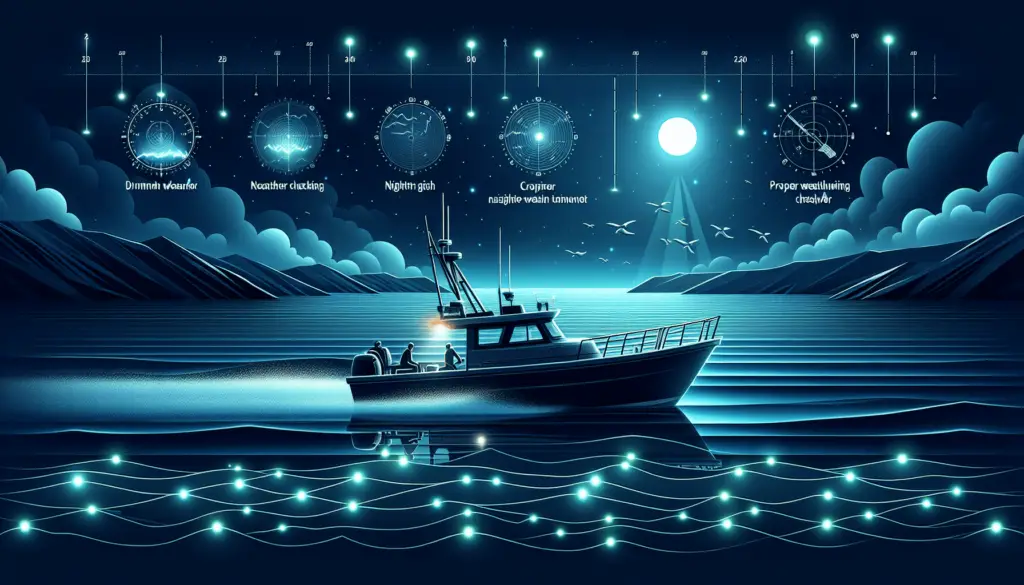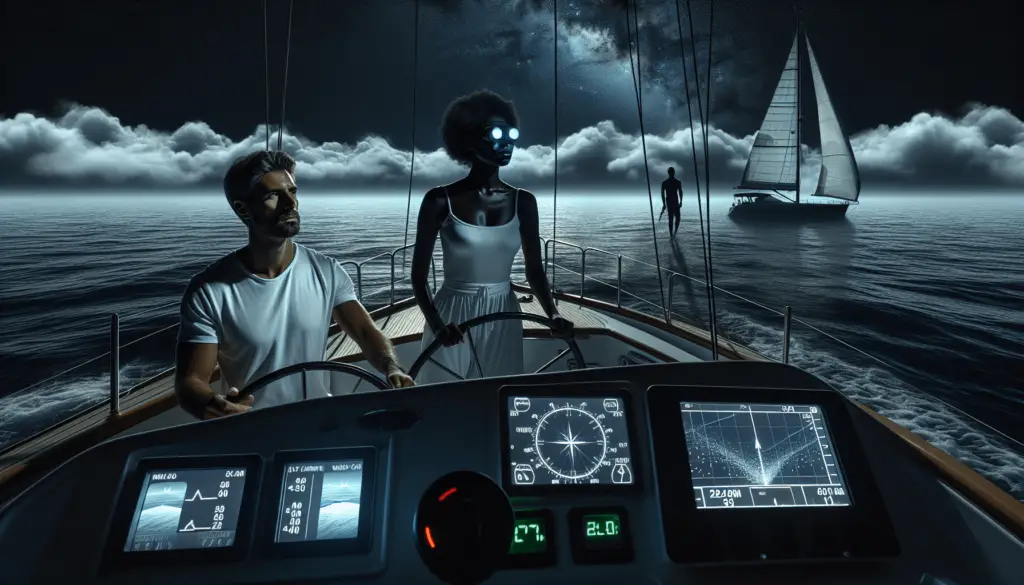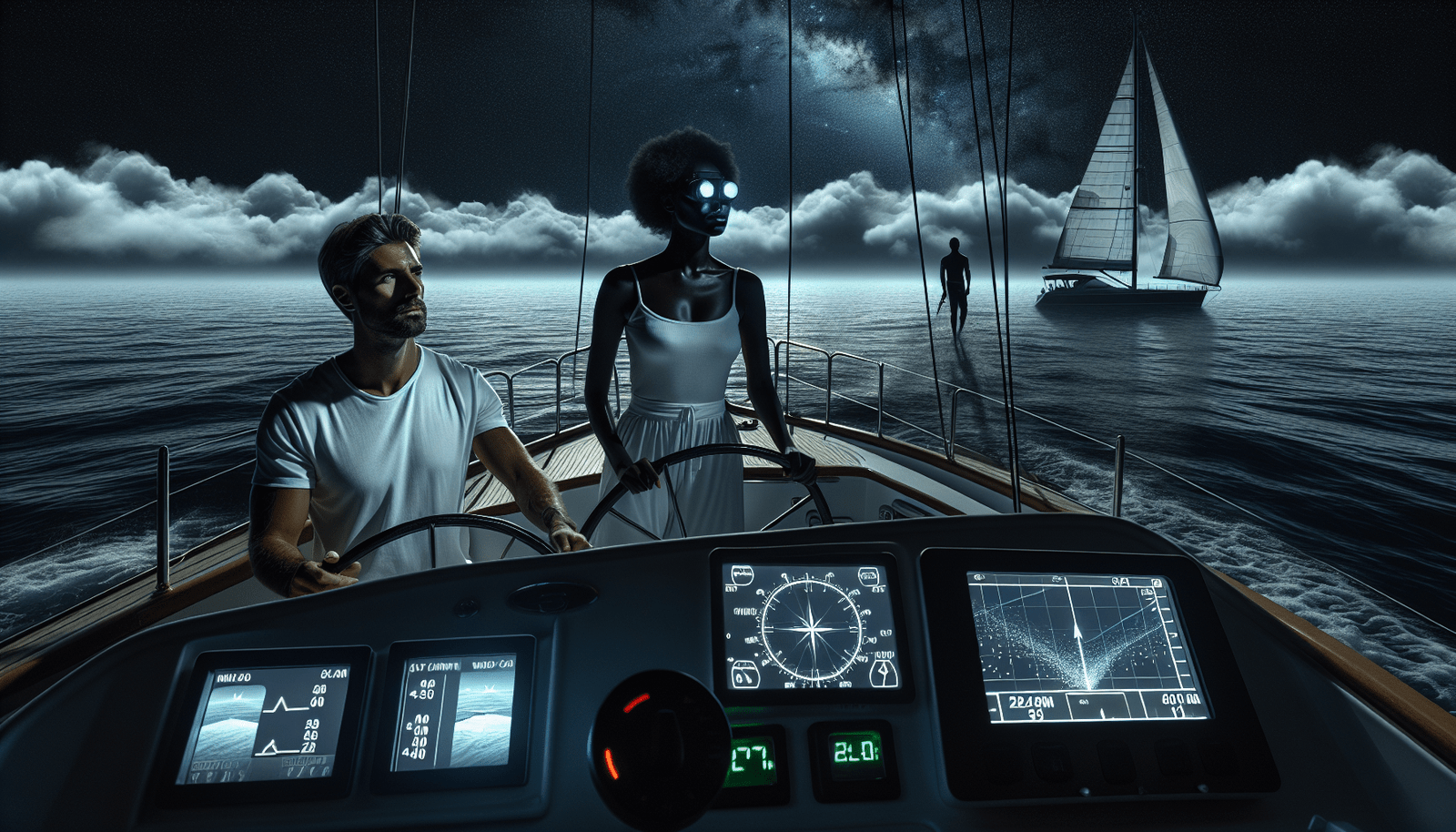Imagine yourself standing on the deck of your boat, the cool evening air grazing your skin, and the moon casting a silver glow over the water. As tranquil as this image may be, venturing out into the waters after sundown poses its own set of unique challenges and risks. “Boating Safety Tips For Nighttime Navigation” will act as your North Star, guiding you through the potential dangers and ensuring that every journey you embark on, whether under the blazing sun or the star-studded night sky, is both safe and enjoyable. The content within will equip you with invaluable tips, enabling you to confidently conquer any night-time maritime escapade.

Understanding the Risks of Night Boating
Nighttime navigation can be a thrilling experience, filled with fresh air and outstanding views. However, it comes with its own set of unique risks and challenges, which you need to understand before taking the helm. navigating in the dark is not the same as during the day, and it calls for a completely different set of skills and precautions.
Lower visibility
One of the biggest risks of night boating is reduced visibility. With lower light levels, it’s harder to see potential obstacles or hazards in the water. This not only includes other boats but also non-illuminated objects such as buoys, docks, or even wildlife. Everything seems to blend into the surrounding darkness, making it harder to spot dangers before they become a problem.
Increased difficulty in judging distances and speed
The dark can also play tricks on your eyes, making it difficult to accurately judge distances and speeds. What might seem like a safe distance during the day can easily turn into a dangerous situation at night. Without clear visual cues, determining if you’re moving too fast or too close to other objects becomes arduous.
Doesn’t respond as swiftly to changes or potential hazards
Your boat may also not respond as quickly to sudden changes or potential hazards at night. This is partly due to the reduced visibility and partly due to the need for slower speeds in dark conditions. These factors can mean potential dangers emerge with little warning and with less time and space to react.
Heightened need for proper preparedness and vigilance
Because of these and other risks, night boating requires a heightened level of preparedness and vigilance. You’ll need a well-maintained boat, the right equipment, and a detailed understanding of navigation techniques and safety procedures. You’ll also need to remain vigilant throughout your trip, constantly watching for potential hazards and ready to respond quickly if any problems arise.
Investing in Right Equipment
Making sure you have the right equipment on board is crucial when night boating. Some of this equipment is unique to nighttime navigation, while others are essential for any type of boating trip and provide an extra layer of safety during the darkness.
Choosing appropriate Lighting devices
Appropriate illumination is crucial for night boating. Do remember that using certain types of lights, such as bright, white floodlights, can hinder your night vision, instead, opt for specialized marine lights that provide enough light without compromising your ability to see. LED lights can be a good choice. Also, carrying a dependable flashlight is inevitable for personal use.
Understanding the importance of quality GPS and Radar systems
In the darkness of night, a quality GPS and Radar systems become your eyes, guiding you through waterways and helping you avoid potential problems. They can provide vital information about your boat’s location, the water depth, and the presence of other vessels or obstacles.
The necessity of having a reliable communication device
Having a reliable communication device is equally essential. This could be a cellphone in a waterproof case or, better yet, a VHF radio that can pick up weather updates and allows communication with the coast guard or nearby ships.
Having safety gear: lifejackets, throwable flotation devices, first aid kit and signaling devices
No matter how calm the water might look, never underestimate the value of standard safety equipment. Ensure that there are enough lifejackets for everyone on board and they fit properly. Throwable flotation devices, a first-aid kit, and signaling devices (like flares or an EPIRB) should also be readily available in case of emergencies.
The value of a night vision equipment
Finally, a night-vision scope or binoculars can be invaluable for spotting potential dangers before they become an issue. By amplifying the available light, these devices can reveal objects that might otherwise be hidden in the darkness.
Importance of Weather Forecasts
Weather plays a significant role in any boating expedition, but its impacts can be even more pronounced at night. Understanding how to anticipate and respond to changing weather conditions is crucial for night boating.
Common weather conditions at night
Nighttime weather conditions often differ from those during the day. Temperatures can drop quickly after the sun sets, potentially creating fog or mist that can reduce visibility even further. Understanding these night-specific weather patterns can help you adequately prepare for your trip.
How to access and interpret reliable weather forecasts
Accessing and correctly interpreting reliable weather forecasts before you set out is a must. Tuning to dedicated VHF radio channels, subscribing to marine weather updates, or downloading weather apps can provide you with real-time weather observations and forecasts to help you plan your trip appropriately and avoid any unwelcome surprises.
Understanding the implications of changing weather patterns on night boating
Evolving weather patterns can have a profound impact on your night boating experience. For instance, sudden wind changes can result in rough seas, making navigation more challenging. Understanding these implications means being prepared with the right gear, knowing when to cut your trip short, and being ready to handle any situation that Mother Nature throws your way.
Prerequisites of Night Navigation
While you can’t control the weather, you can control your knowledge and preparation. Learning about the area you’ll be navigating, understanding the principles of marine navigation, knowing local laws, and being able to recognize nautical symbols are all prerequisites that one must acquire before venturing out into the night sea.
Getting familiar with the chosen boating area during daytime
Before you attempt to navigate a particular area at night, spend time there during the day. Understanding the layout, recognizing landmarks, and noting potential hazards can help make your nighttime journey safer.
Understanding marine charts and navigational aids
A marine chart plotter is not just a map but a vital tool that can be your best friend when navigating unfamiliar waters, especially in the darkness. It provides crucial details about water depth, obstacles under water, the location of buoys, and navigational aids. Having a sound knowledge of how to interpret these charts underlies safe nighttime navigation.
Knowing local laws and regulations
Every water body can have specific rules and regulations, from speed limits to right-of-way rules. Understanding these local laws and regulations will help you navigate safely and avoid dangerous situations that could lead to accidents or penalties.
Recognizing nautical symbols and night markers
Finally, being able to recognize nautical symbols and night markers is a fundamental skill for night navigation. It will guide you through waterways, helping you steer clear from obstacles and avoid dangerous waters.

Pre-Departure Checklist
Before you set sail into the night, a thorough pre-departure checklist can ensure that your vessel is ready to tackle the journey ahead — making it more of a memorable experience rather than a dreadful voyage.
Battery check and power supply
When you’re relying on electronic devices for navigation and safety, checking your power supply becomes crucially important. This not only includes making sure your batteries are fully charged but also that you have backup power options and functioning charging systems.
Equipment function test
Testing all your equipment before you hit the water is another sailing protocol. This includes everything from your GPS and radar systems to your lights, radio, and safety gear. It’s much better to discover a potential problem while you’re still at the dock than when you’re out on the water in the dark.
Safety gear inventory
Understanding what safety gear you have on board and ensuring it’s all in working order is also a must. Review these items in daylight conditions to make sure they are accessible and in good condition. Having a rescue plan in place and ensuring everyone on board is familiar with it is a step that should never be overlooked.
Communicating your travel plan and expected return
Before leaving, be sure to tell someone trustworthy about your travel plans and expected return time. If anything goes wrong, they should know where to start looking and when to alert authorities.
Proper Use of Lighting
Getting your lighting right can be a fine art at sea during the night. It’s about more than just being able to see. It’s also about maintaining night vision, not blinding other sailors, and effectively signaling your vessel’s size, type, and orientation to others on the water.
Understanding types of boat lights and their purposes
Various boat lights serve different purposes. Navigation lights, for instance, help other vessels see you and understand your direction. Anchor lights signal that you’re stationary. Knowing these lights and their specific uses can ensure you’re not creating confusing signals for others in the vicinity.
Correct positioning and use of lights
Each type of light needs to be correctly positioned on your boat and used correctly. Navigation lights need to be visible from a certain distance depending on the size of your boat, while anchor lights need to be at the highest point on the boat to be seen from all around. Incorrect positioning or use of lights can confuse other boaters and potentially lead to accidents.
Balancing between visibility and night blindness causes
While having enough light to see is important, too much light can be just as dangerous. Overly bright lights can cause glare, reducing your ability to see through the night effectively. Striking a balance between visibility and avoiding night blindness is essential.
How to interpret lights from other vessels
Just as your lights can signal information about your vessel to others, you can interpret lights from other vessels to understand their size, type, and orientation, thus helping you navigate safely around them.
Night Navigation Techniques
Successful night navigation brings together many different skills, creating a unique challenge that requires concentration, knowledge, and adaptability.
Maintaining low speed
A lowered speed gives you more time to spot potential hazards, to process information, and to react accordingly. The darkness of the night naturally imposes restrictions on your vision, making it vital to cruise at a lower speed.
Relying on chart-plotter and radar
A chart-plotter and radar are your best friends at night. They provide you with crucial information about your boat’s position, water depth, and the presence of other vessels or obstacles. Learn to rely on them and not just your eyes.
Proper look out duties
Maintaining a diligent watch is much more difficult but also more critical during night navigation. Ideally, have a dedicated crew member focused solely on looking out for potential hazards and checking the horizon regularly.
Use of triangulation for positioning
The use of triangulation – using two known locations to determine your position – can be an effective way to confirm your position and can serve as a backup if your electronics fail.
Communication Protocols
Communication protocol on the water – like elsewhere – is based on understanding and using the right channel, knowing the right language, and respecting others.
Using VHF radio
A VHF radio is crucial for emergency communication and regular ship-to-ship or ship-to-shore contacts. Understanding how to use it, including knowing which channel to use for routine, safety, and emergency communications, is essential.
Understanding proper radio etiquette
Knowing the proper etiquette for using the VHF radio is vital. This can include a range of practices, from using correct marine language and terms, to keeping transmissions brief, to never interrupting ongoing emergency transmissions.
Communicating your position accurately with other boats or coast guard
In emergencies, effectively communicating your vessel’s position to others or the coast guard can be the difference between a swift rescue and a dire situation. Regular practice using both GPS coordinates and visual landmarks is a good idea.
Common Night Boating Hazards
Understanding common night boating hazards can help to prevent incidents. The more knowledge and training you have, the better equipped you will be to handle any situation you may encounter.
Identifying shallow waters
Shallow waters can be much harder to spot at night than during the day. Developing a keen understanding of your marine charts and sonar readings can be crucial to avoid running aground.
Awareness of other vessels
Other vessels (especially those without adequate lighting) can pose a significant risk at night. Regular scans of the horizon and reliance on your radar system are essential practices.
Risks of getting lost or disoriented
In the darkness of the night, familiar landmarks disappear and the risk of disorientation significantly increases. Keeping a close track of your direction, using your GPS, and confirming your position regularly can prevent you from getting lost.
Dealing with emergent weather patterns
Rapidly changing weather patterns can prove to be a considerable challenge during night boating. Regular weather checks and understanding alternative routes or shelters can help manage this risk.
Safety Procedures in Case of Emergencies
While you should do everything in your power to prevent emergencies, knowing how to react if an emergency arises is just as important.
How to send a distress signal
There are a variety of ways you can send a distress signal – from a handheld flare to a distress call on the VHF radio to emergency signals on your EPIRB. The key is to know how to use all the methods available to you and to understand when each one is the most appropriate.
Dealing with grounding or collision
If your boat ends up grounding or colliding with another object, the first step is to ensure everyone on board is safe. Then, assess the boat’s damage and communicate your situation and location immediately to other vessels or the coast guard.
Handling man overboard situations
Should someone fall overboard, quick and calm action is essential. Throw a flotation device, mark the spot using GPS, keep constant visual contact, and follow overboard protocols critically to ensure a safe recovery.
Responding to unexpected weather shifts
An unexpected weather shift can produce dangerous conditions with little warning. Understanding how to adapt your tactics to these changes, or deciding to seek safe harbor, can prevent potential disasters.
In conclusion, night boating presents an adventure of its own, but it is not without its challenges. Being well-prepared, understanding the inherent risks, and diligently following all the necessary safety procedures ensure a safe journey. Even in darkness, armed with knowledge and preparation, you can confidently sail knowing that the sparkling night sky is the perfect companion. Happy boating!

